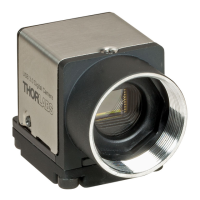© 2013 Thorlabs GmbH
2 Camera Basics
41
2.5.2 Bit Depth and Digital Contrast Adjustment
Digitizing
Image sensor pixels first generate an analog voltage signal proportional to the amount of light that strikes them.
The image is digitized for further processing, i.e. the stepless signal is converted to a digital numerical value. The
following figure shows this using a gray gradient as an example
Various bit depths using a gray-scale gradient as an example
If the stepless gradient is imaged in a digital range in 2 bits, for example, the result is 2
2
= 4 levels; for 4 bits, it is
2
4
= 16 levels, and so on. The intermediate brightness values of the original gradient are irreversibly lost after
digitization.
With around 200 levels or more, the jumps in brightness can no longer be discerned with the eye, which is why
current monitors and digital cameras use 8 bits (256 levels) per color channel (fully adequate for visualization).
Bit depth in image processing
If digital image data undergoes further image processing, a bit depth greater than 8 may be necessary. The
computer is able to differentiate between these very fine differences in brightness (no longer discernable by the
eye) and process them. This is why industrial cameras often use 12 bits.
Note
Greater bit depths require extremely low-noise image sensors, however. As soon as the differences in brightness
created by noise are greater than the digitization levels, no further data is gained.
Bit depth by sensors
Note
Color formats with a bit depth of more than 8 bits per channel are only supported by USB 3 DCC3240x camera
models. Using color formats with higher bit depth increases the bandwidth used by a camera.
Histogram and contrast
The brightness distribution of digital images is represented in a histogram. If an image has optimum contrast, the
histogram includes practically all brightness values between 0 and the highest value (255 in 8-bit images). If an
image has low contrast, the histogram only includes a small number of the values; the image appears dull:

